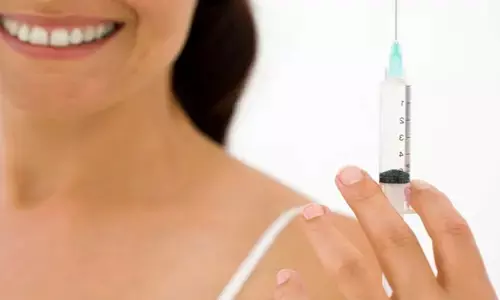- Home
- Medical news & Guidelines
- Anesthesiology
- Cardiology and CTVS
- Critical Care
- Dentistry
- Dermatology
- Diabetes and Endocrinology
- ENT
- Gastroenterology
- Medicine
- Nephrology
- Neurology
- Obstretics-Gynaecology
- Oncology
- Ophthalmology
- Orthopaedics
- Pediatrics-Neonatology
- Psychiatry
- Pulmonology
- Radiology
- Surgery
- Urology
- Laboratory Medicine
- Diet
- Nursing
- Paramedical
- Physiotherapy
- Health news
- Fact Check
- Bone Health Fact Check
- Brain Health Fact Check
- Cancer Related Fact Check
- Child Care Fact Check
- Dental and oral health fact check
- Diabetes and metabolic health fact check
- Diet and Nutrition Fact Check
- Eye and ENT Care Fact Check
- Fitness fact check
- Gut health fact check
- Heart health fact check
- Kidney health fact check
- Medical education fact check
- Men's health fact check
- Respiratory fact check
- Skin and hair care fact check
- Vaccine and Immunization fact check
- Women's health fact check
- AYUSH
- State News
- Andaman and Nicobar Islands
- Andhra Pradesh
- Arunachal Pradesh
- Assam
- Bihar
- Chandigarh
- Chattisgarh
- Dadra and Nagar Haveli
- Daman and Diu
- Delhi
- Goa
- Gujarat
- Haryana
- Himachal Pradesh
- Jammu & Kashmir
- Jharkhand
- Karnataka
- Kerala
- Ladakh
- Lakshadweep
- Madhya Pradesh
- Maharashtra
- Manipur
- Meghalaya
- Mizoram
- Nagaland
- Odisha
- Puducherry
- Punjab
- Rajasthan
- Sikkim
- Tamil Nadu
- Telangana
- Tripura
- Uttar Pradesh
- Uttrakhand
- West Bengal
- Medical Education
- Industry
Ester form of hyaluronic acid matrix alongwith negative pressure wound therapy helps in better wound healing

A new study published in Wounds Journal suggests that for the management of chronic wounds with revealed bone and tendon, ester form of hyaluronic acid matrix (eHAM) works better when combined with negative pressure wound therapy (NPWT).
Wet-to-moist dressing application, primary infection control, surgical, mechanical, or chemical debridement, and care of LEWs like chronic ulcers have traditionally been the cornerstones of soft tissue wound healing. A potent approach for promoting wound healing is the use of biomaterials to construct and alter the wound microenvironment and encourage cell migration. The current investigation examines the impact of NPWT and eHAM on the healing of soft tissue wounds in 10 individuals using a retrospective case series. Tracy Robertson and team conducted this study with the goal to ascertain if NPWT with eHAM will shorten the amount of time needed for skin grafting and wound healing as compared to NPWT without eHAM. Every patient received care in an outpatient clinic.
Ten patients in all, 8 males and 2 females, with ages ranging from 48 to 81, were assessed. All patients received treatment for LEWs associated with a variety of comorbidities, such as obesity, hyperlipidemia, peripheral neuropathies, hypertension, insulin- and non-insulin-dependent diabetes, respiratory issues, coronary artery disease, and peripheral neuropathies. Patients were chosen for NPWT therapy with or without eHAM depending on how similar their wounds were to one another.
An eHAM (Hyalomatrix; Medline Industries) was utilised in the current study by the authors to treat wounds after extensive surgical debridement and wound bed preparation. Five patients received NPWT plus eHAM treatment (group 1), whereas five patients received NPWT only (group 2). During the course of therapy, every patient had at least 1 autologous skin transplant (STSG or FTSG). The number of weeks until wound closure, the rate of wound closure, the number of weeks until skin transplant, and the rate of skin graft were compared between group 1 and group 2 using T tests with unequal variance.
The key findings of this study were:
1. Despite an almost twice bigger initial wound size, the average time to closure was comparable between group 1 and group 2 (15.2 weeks versus 14.6 weeks).
2. However, group 1 saw a higher rate of wound closure each week than group 2, both in terms of area (9.0 cm2 vs. 6.8 cm2) and volume (12.3 cm3 vs. 5.4 cm3).
3. Additionally, group 1 had a faster rate of wound closure each week following skin grafting in terms of both area (4.5 cm2 vs 3.8 cm2) and volume (25.9 cm3 vs 4.1 cm3).
4. Skin grafts were administered to every patient in group 1 within two to three weeks of their second eHAM administration.
Reference:
Robertson, T., & Benitez, L. (2023). Reduced Time to Skin Grafting in Chronic Wounds Using an Esterified Hyaluronic Acid Matrix and Negative Pressure Wound Therapy. In Wounds: a compendium of clinical research and practice (Vol. 35, Issue 5, pp. 99–107). HMP Communications, LLC. https://doi.org/10.25270/wnds/21081
Neuroscience Masters graduate
Jacinthlyn Sylvia, a Neuroscience Master's graduate from Chennai has worked extensively in deciphering the neurobiology of cognition and motor control in aging. She also has spread-out exposure to Neurosurgery from her Bachelor’s. She is currently involved in active Neuro-Oncology research. She is an upcoming neuroscientist with a fiery passion for writing. Her news cover at Medical Dialogues feature recent discoveries and updates from the healthcare and biomedical research fields. She can be reached at editorial@medicaldialogues.in
Dr Kamal Kant Kohli-MBBS, DTCD- a chest specialist with more than 30 years of practice and a flair for writing clinical articles, Dr Kamal Kant Kohli joined Medical Dialogues as a Chief Editor of Medical News. Besides writing articles, as an editor, he proofreads and verifies all the medical content published on Medical Dialogues including those coming from journals, studies,medical conferences,guidelines etc. Email: drkohli@medicaldialogues.in. Contact no. 011-43720751


